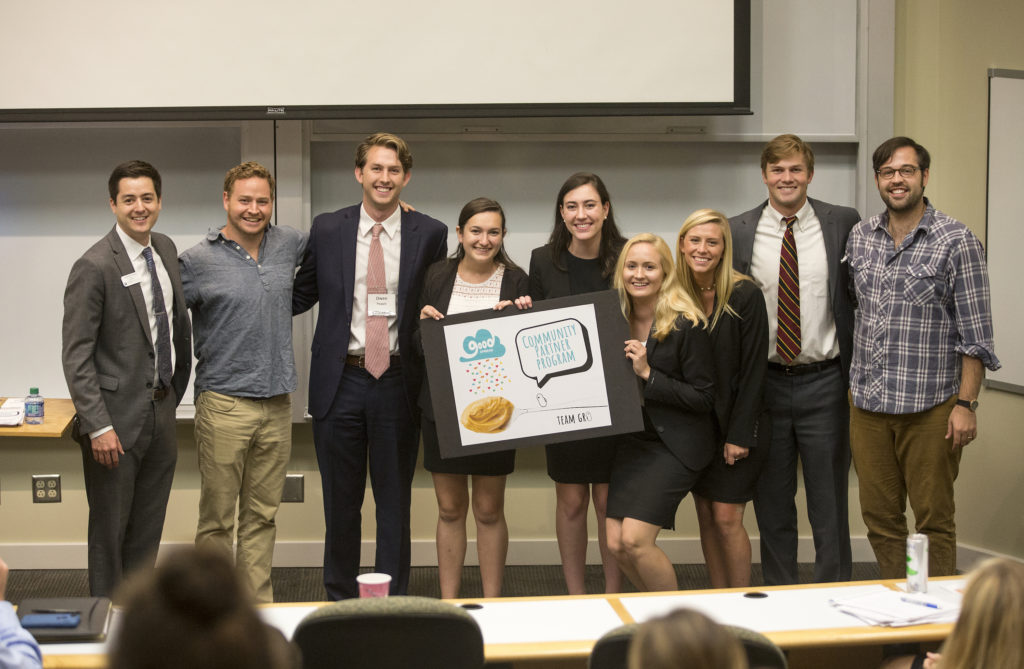By Nathaniel Luce
Good Spread, an organic peanut butter company founded in 2011, is a company with a simple mission — to help good spread. How do they spread the good? By fighting one of the most devastating inflictions in the developing world: severe acute malnutrition.
For every purchase of Good Spread peanut butter, a malnourished child receives a packet of ready-to-use-therapeutic food (RUTF), provided by the MANA Nutrition and distributed through World Vision in several African countries.
Leveraging the buy-one-give-one model pioneered by Toms Shoes, Good Spread has delivered over 33,000 packets of RUTF to children in need. With product on the shelves at Whole Foods, Harris Teeter, Kroger, and small grocers, as well as Amazon, the company turned to Accelerator to build awareness of the brand and mission on campus, through development of a college ambassador program.

Good Spread’s Mark Slagle and Daniel Anderson
College Ambassadors are big business — brands like Coca-Cola, Apple, and Victoria’s Secret engage in campus rep programs across the country. The trend isn’t unique for socially minded enterprises like Good Spread either: Love Your Melon is just one example of retail-centric enterprises using the ambassador model to promulgate missions and brand awareness amongst young consumers.
But like any good strategy, success lies in execution, especially when the strategy involves motivating and sustaining the interest of college students with shifting priorities and demands on their time. Co-Founder Mark Slagle and Community Engagement Director Daniel Anderson put it to four Accelerator teams to create a turn-key solution for a college ambassador program, which included plans for launch, management and sustainability, and financials. As is the case with many young enterprises, resources were slim.
“We’re on a very limited budget, so we had to think about how do we entice people to become part of this program without spending any money,” said Natalie Jones, an Accelerator student from Pepperdine University that participated in the Good Spread project. “We’re really having to come up with creative ideas to engage without spending money, which is definitely a challenge but really exciting at the same time.”
Team strategies overlapped considerably in terms of marketing channels — social media was a cornerstone of every presentation, and Greek systems were a popular target — but logistical considerations and targeting strategies were precise and unique, due in large part to team members’ past experience with ambassador programs. Establishing consistent expectations through team charters and constitutions, implementing communications platforms like Slack and GroupMe, and hiring regional leadership were presented in strong detail and well-received by Slagle and Anderson. From a promotional perspective, hashtag-branded social competitions, use of the company’s revered Winnebago, and opportunities to meet impacted children were all considered.
(This project) really is a big deal, because it allows us to sell more and save more lives. We’re going to be using components of every single presentation. – Mark Slagle
For Slagle and Anderson, the biggest challenge was settling on a winning team. “You guys have all been so good,” Slagle told team members. “We had 15 minutes (to decide), and we needed 3 hours.”
After fierce deliberations, Team 8 was selected as the winner, with Slagle and Anderson cited the team’s focus on story-telling, thoughtful community building through technology, and regional management structure as the difference-makers.
They commended every team for their thoughtful analysis and recommendations. “This (project) has saved us so many hours of work, and helped us in so many ways, so that we can better spread the word of Good Spread,” Slagle said.
“It really is a big deal,” he added, “because it allows us to sell more and save more lives. We’re going to be using components of every single presentation.”
The mission-based approach to Good Spread certainly hit home with team members. “(Slagle) had created this product that was so delicious, but behind it was such a deeper drive for him, and it all made us so much more attached to the mission,” said Jones.

Good Spread celebrates with Team 8